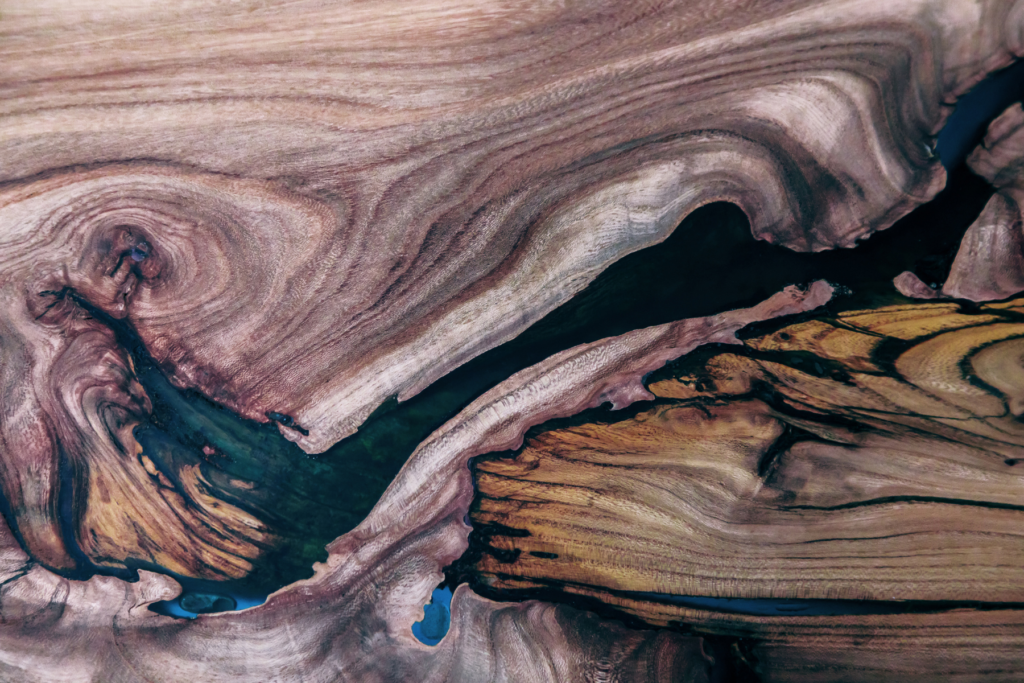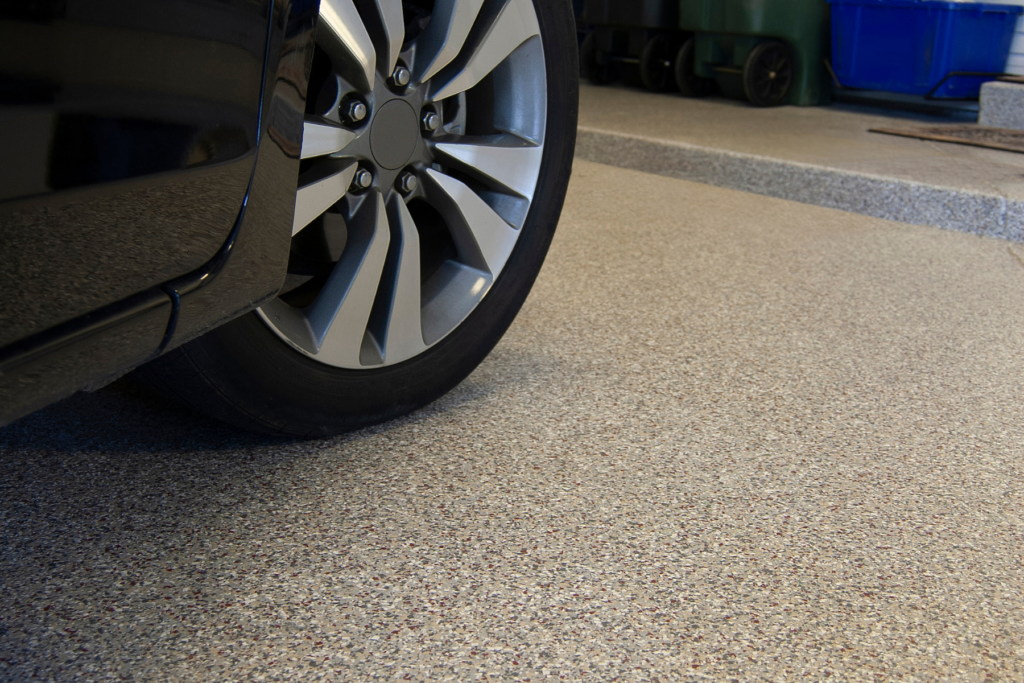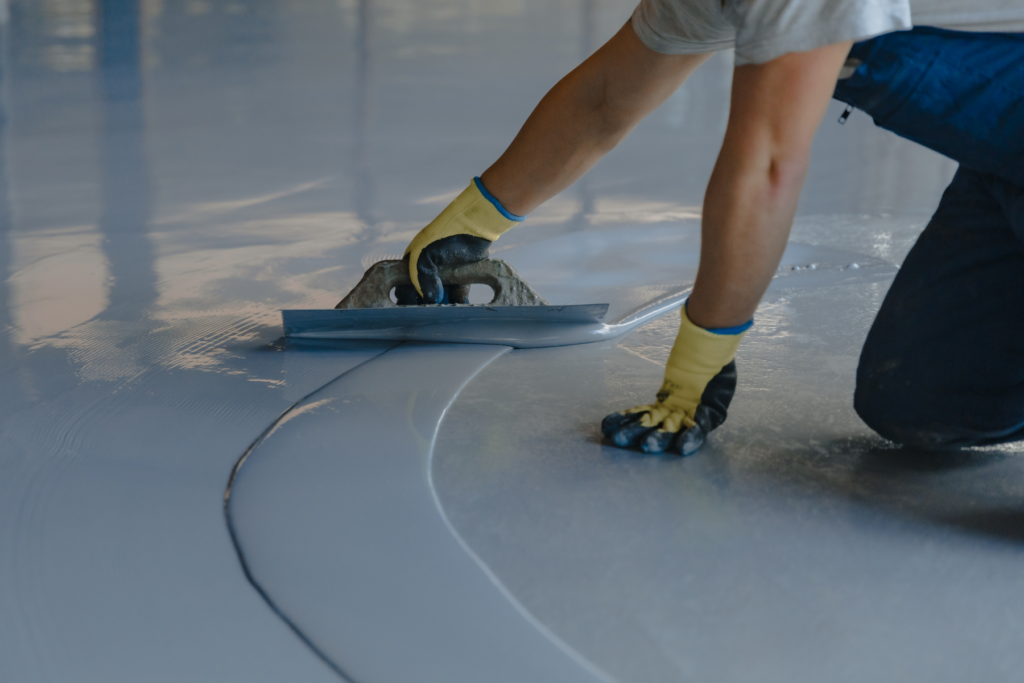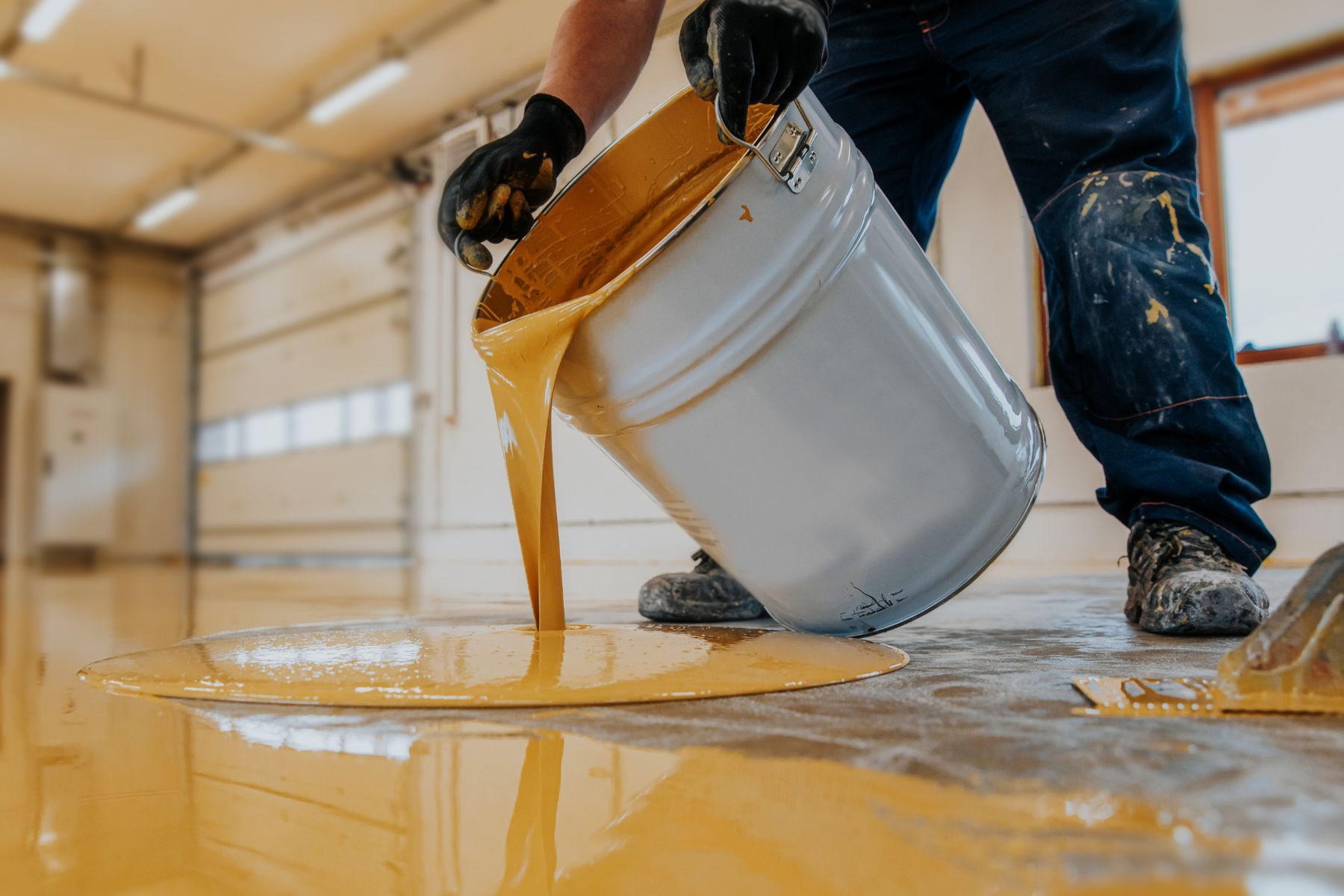Floor coatings serve as the protective and aesthetic mantle for many spaces.
Whether it’s a warehouse, a garage floor coating, an outdoor patio, or any concrete floor, the right floor coating not only enhances the appearance but also extends the lifespan of the floor.
This article aims to simplify your decision-making process by comparing two of the most popular floor coatings: polyurea and epoxy.
We’ll explore their chemical compositions, features, and ideal applications, and even delve into real-world case studies.

Polyurea vs. Epoxy Floor Coatings in the Garage
What is Polyurea Floor Coating?
Polyurea is the outcome of a chemical reaction involving isocyanate and a resin blend.
The hallmark of polyurea, or polyaspartic floor coating, is its incredibly quick curing time—sometimes just a matter of seconds to minutes.
This speed is invaluable for projects on tight deadlines.
In addition to its rapid curing, polyurea flooring exhibits superior flexibility, allowing it to adapt to varying conditions without cracking.
The material is also highly resistant to chemicals, moisture, and UV radiation, making it suitable for a wide range of indoor and outdoor applications.
Polyurea concrete coatings are what I have on my garage floor… and I love the top coat.
The color coat is white, black, and red, with silver glitter and a clear coat on top.
What is Epoxy Floor Coating?
Epoxy floor coatings are made from epoxy resins and hardeners.
Unlike polyurea, epoxy has a much longer curing time—often requiring up to 48 hours to fully set.
On the upside, epoxy resin is lauded for its durability and chemical resistance.
It forms a hard, impenetrable surface that can withstand heavy machinery, foot traffic, and chemical spills.
However, epoxy is not UV resistant, limiting its use to indoor applications.

Polyurea vs. Epoxy Features
Durability
Epoxy coatings excel in indoor environments where they can last for years with minimal wear and tear.
However, they may degrade when exposed to UV rays.
Polyurea coatings are UV-stable and can withstand external elements more effectively, making them more versatile in both indoor and outdoor applications.
Flexibility
Polyurea’s unique molecular structure gives it elasticity, allowing the material to expand and contract with temperature fluctuations.
This characteristic minimizes the risk of cracking due to environmental stresses.
Epoxy is rigid and can crack when subjected to similar stresses, requiring more frequent maintenance to keep the surface intact.
Curing Time
In numerous projects, the essence of time is paramount.
For those under the pressure of tight deadlines, the rapid curing time of polyaspartic coatings can come as a blessing, potentially rescuing the project from delays.
On the other hand, epoxy flooring, with its extended curing duration, implies that the designated area will remain unusable for an extended interval.
This prolonged downtime can be particularly problematic in commercial environments where continuous operations are crucial.
Such disruptions can affect productivity and lead to potential financial implications.
Aesthetic Appeal
Polyurea and epoxy coatings offer a range of colors and finishes to cater to different preferences.
While both have their merits, epoxy stands out in terms of personalization capabilities.
Not only can you introduce flakes and distinct patterns with epoxy, but you can also embed mesmerizing 3D effects directly into its surface during the application process.
This versatility makes epoxy especially appealing to those who prioritize aesthetics in their projects.
As a result, for projects that demand a higher level of visual appeal and uniqueness, epoxy often becomes the choice of many designers and homeowners.
Chemical Resistance
Both coatings – polyurea and epoxy – offer chemical resistance.
However, polyurea boasts a higher resistance level to a wider range of harsh chemicals than epoxy.
This increased resilience makes polyurea particularly suitable for industrial environments with a concrete surface.
In such settings, it stands up better against diverse substances that might be encountered.
Safety and Environment
Epoxy coatings often contain volatile organic compounds (VOCs) that can necessitate proper ventilation when being applied to prevent harmful fumes.
This makes the application process of epoxy more cautionary and can be concerning for those involved.
In contrast, polyurea is frequently free of VOCs, making it a more environmentally friendly option.
Additionally, this absence of VOCs in polyurea translates to a safer experience for both the environment and the individuals who are applying the coating.
Cost
Epoxy coatings may seem more cost-effective initially, but the overall cost-benefit can be deceptive.
Taking into account the potential for cracking, UV degradation, and more frequent maintenance, polyurea often becomes the more cost-efficient option in the long run.
Consider all of this to determine the best option for you.

Polyurea vs. Epoxy Applications
Industrial Applications
For business owners looking to choose the right flooring for their warehouses, the decision between polyurea and epoxy is critical.
Both coating systems can enhance the safety of a warehouse floor by providing a durable, non-slip surface.
However, polyurea tends to offer superior resistance to chemicals and abrasions compared to epoxy, making it a better choice in high-traffic and rigorous industrial environments.
Additionally, polyurea has fast cure rates (faster than epoxy), allowing for shorter downtime and quicker return to operations.
In terms of cleanliness, both coatings create seamless surfaces that are easy to clean and maintain, which is an important aspect of keeping a warehouse safe from possible injuries.
However, given polyurea’s heightened resistance, it might offer longer-lasting protection against stains and spills, making warehouse maintenance a smoother task for business owners.
Residential Applications
For homes and residential spaces, epoxy stands out due to its versatility in aesthetic designs and its resilience against everyday household chemicals.
This means homeowners can enjoy a beautiful finish that’s also durable against spills and stains.
Additionally, while epoxy does have a longer curing time, this isn’t typically a major concern in a residential context where immediate use isn’t always pressing.
In settings where there’s flexibility in the project timeline, this extended cure time can be easily accommodated.
Specialized Applications
Polyurea garage floor coatings boast a distinct blend of attributes: a rapid curing time, resilience to UV rays, and unparalleled chemical resistance.
These qualities not only make it an ideal selection for outdoor patios and swimming pool decks but also render it highly suitable for food production areas.
In these latter environments, ensuring health and safety is of utmost importance.
As such, when a strong and reliable coating solution is sought, polyurea often emerges as the best choice for many professionals and industries.
Accessible Applications
Epoxy and polyurea are both excellent choices for wheelchair ramp coatings, but they offer distinct benefits.
Epoxy is known for its longevity and provides a durable, smooth surface that can be especially useful for wheelchairs.
On the other hand, polyurea dries faster and is more flexible, allowing it to better handle temperature changes and resist cracking.
Given the increasing number of people searching for accessible housing online, investing in a high-quality ramp coating can be a significant selling point for property listings.

Polyurea vs. Epoxy Factors to Consider
Project Needs
To make an informed decision, it’s crucial to start by assessing your specific requirements in detail.
Take a moment to reflect on what is most important for your project.
Is it rapid curing, UV resistance, or perhaps aesthetic appeal?
By pinpointing your priorities, you’ll be better equipped to select the ideal material for your needs.
For this, I suggest contacting professional installers who are well-versed in concrete coatings.
Budget
At first glance, epoxy systems might seem like a budget-friendly option.
However, it’s essential to consider the long-term implications of your choice.
Over time, the costs associated with maintaining and potentially replacing epoxy can add up.
On the other hand, aliphatic polyurea boasts durability and requires less maintenance.
As a result, polyurea might present a more favorable return on investment in the long run.
Long-Term Maintenance
Epoxy, while effective, often demands supplementary layers as it wears down, particularly in areas with heavy foot traffic or those exposed to the elements outdoors.
Over time, this can result in additional costs and maintenance efforts.
On the other hand, polyurea stands out due to its increased durability and versatility.
Because of these attributes, it often proves to be a more cost-effective solution in the long run.
This is mainly because polyurea’s resilience means fewer instances of required repairs or re-applications.
Consequently, when evaluating lifetime costs, polyurea often emerges as the more economical choice due to its longevity.
Aesthetic Preferences
When considering the visual appeal and design of your project, epoxy paint offers a distinct advantage due to its higher customizability, allowing for a wider range of finishes and designs.
This could be a game-changer if aesthetics are paramount to you.
On the other hand, for projects that are based outdoors, it’s essential to think about the impact of direct sunlight. In such cases, polyurea’s ability to resist UV degradation gives it a competitive advantage.
The choice between polyurea and epoxy floor coatings depends on various factors, including the project’s requirements, budget, and long-term maintenance expectations.
Both materials have distinct advantages and disadvantages, making them more suitable for specific scenarios, but I am partial to my polyurea garage floor coatings.
By understanding your unique needs and circumstances, you can make an informed decision that will benefit you for years to come.
This is an edited guest post by Tomas Hodge at Flood Safety.
